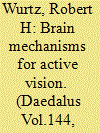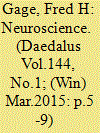| Srl | Item |
| 1 |
ID:
137655


|
|
|
|
|
| Summary/Abstract |
Active vision refers to the exploration of the visual world with rapid eye movements, or saccades, guided by shifts of visual attention. Saccades perform the critical function of directing the high-resolution fovea of our eyes to any point in the visual field two to three times per second. However, the disadvantage of saccades is that each one disrupts vision, causing significant visual disturbance for which the brain must compensate. Exploring the interaction of vision and eye movements provides the opportunity to study the organization of one of the most complex, yet best-understood, brain systems. Outlining this exploration also illustrates some of the ways in which neuroscientists study neuronal systems in the brain and how they relate this brain activity to behavior. It shows the advantages and limitations of current approaches in systems neuroscience, as well as a glimpse of its potential future.
|
|
|
|
|
|
|
|
|
|
|
|
|
|
|
|
| 2 |
ID:
137654


|
|
|
|
|
| Summary/Abstract |
Neuroscience is the scienti½c study of the nervous system (the brain, spinal cord, and peripheral nervous system) and its functions. The belief that the brain is the organ that controls behavior has ancient roots, dating to early civilizations that connected loss of function to damage to parts of the brain and spinal cord. But the modern era of neuroscience began–and continues to progress–with the development of tools, techniques, and methods used to measure in ever more detail and complexity the structure and function of the nervous system. The modern era of neuroscience can be traced to the 1890s, when the Spanish pathologist Santiago Ramón y Cajal used a method developed by the Italian physician Camillo Golgi to stain nerve tissues to visualize the morphology and structure of the neurons and their connections. The detailed description of the neurons and their connections by Cajal, his students, and their followers led to the “neuron doctrine,” which proposed that the neuron is the functional unit of the nervous system
|
|
|
|
|
|
|
|
|
|
|
|
|
|
|
|